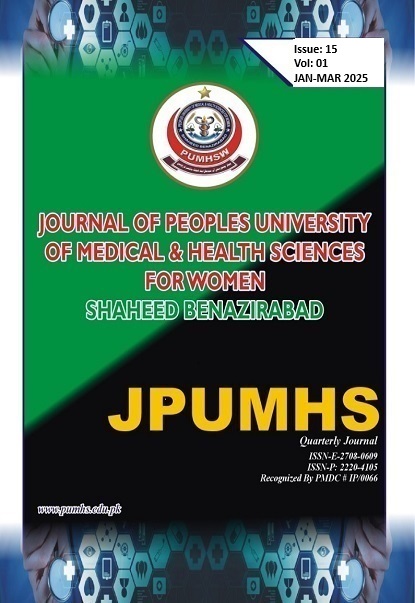EVALUATION OF ANTIBIOTIC SUSCEPTIBILITY PATTERNS OF BACTERIAL PATHOGENS IN CLINICAL SPECIMENS.
JPUMHS; 2025:15:01, 146 157. http://doi.org/10.46536/jpumhs/2025/15.01.608
Keywords:
Drug Resistance, Bacterial, Microbial Sensitivity Tests, Gram-Negative Bacterial InfectionsAbstract
BACKGROUND: The prevalence of bacterial resistance to antibiotics has escalated in recent
years. Resistance against Gram-negative bacteria (GNB) and Gram-positive bacteria (GPB)
has been documented. OBJECTIVE: This study investigated the frequency, antibiotic
susceptibility, and resistance mechanisms of clinical sample isolates from Department of
Pathology.MATERIAL AND METHOD: This study investigated the frequency, antibiotic
susceptibility, and resistance mechanisms of clinical sample isolates from Department of
Pathology. Aseptically collected 793 bacterial isolates from wound swabs, urine, blood, central
venous pressure line tips, and respiratory specimens to grow on CLED or Blood agar for 24
hours at 37°C. The isolate will be identified using microbiological methods after culture.
RESULT: From wound samples, which included pus, swabs, and tissue, 237 bacterial isolates
were identified: Enterococcus species (n=59, 24%), Enterobacterales (n=148, 62%), and
Pseudomonas aeruginosa (n=30, 12%). The urine sample produced a uniform distribution and
quantity of isolates. In blood and CVP line tip cultures, 168 bacterial isolates were detected,
including Acinetobacter species (n=37, 22%), Enterobacterales (n=56, 33%), and Salmonella
Typhi (n=75, 44%). Included were Escherichia coli (n=8, 5.2%), Acinetobacter species (n=46,
30%), Klebsiella pneumoniae (n=20, 13.2%), and Pseudomonas aeruginosa (n=77, 50%).
Whereas Ciprofloxacin resistance varied from 65–68% across locations, pus swab and urine
isolates were resistant to Penicillin (75%) and Ampicillin (97%). Respiratory samples were
moderately resistant to Ciprofloxacin (65.2%) and Gentamicin (52.8%) but low to Polymyxin
B (6.2%) and Tigecycline (13.7%). These results show extensive first-line antibiotic resistance
and continued vulnerability to last-resort medicines. CONCLUSION: This study shows that
diverse clinical specimens often resist common antibiotics. The effectiveness of last-resort
medicines like Polymyxin B and Tigecycline shows their importance in treating multidrug
resistant diseases.
Downloads
Downloads
Published
How to Cite
Issue
Section
License

This work is licensed under a Creative Commons Attribution-NoDerivatives 4.0 International License.




